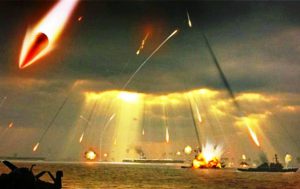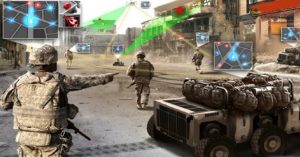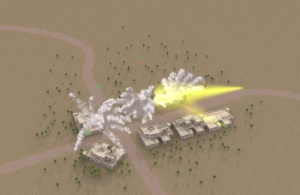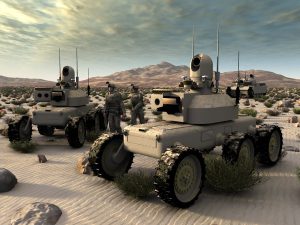The Mad Scientist Initiative recently facilitated a workshop with thought leaders from across the Department of Defense, the Intelligence Community, other Government agencies, industry, and academia to address the unknown, unknowns (i.e., Black Swans) and the known, knowns (i.e., Pink Flamingos) to synthesize cross-agency thinking about possible disruptions to the Future Operational Environment.
 Black Swans: In Nassim Nicholas Taleb’s original context, a black swan (unknown, unknowns) is an event or situation which is unpredictable, but has a major effect. For this conference, we used a looser definition, identifying possibilities that are not likely, but might have significant impacts on how we think about warfighting and security.
Black Swans: In Nassim Nicholas Taleb’s original context, a black swan (unknown, unknowns) is an event or situation which is unpredictable, but has a major effect. For this conference, we used a looser definition, identifying possibilities that are not likely, but might have significant impacts on how we think about warfighting and security.
 Pink Flamingos: Defined by Frank Hoffman, Pink Flamingos are the known, knowns that are often discussed, but ignored by Leaders trapped by organizational cultures and rigid bureaucratic decision-making structures. Peter Schwartz further describes Pink Flamingos as the “inevitable surprise.” Digital photography was a pink flamingo to Kodak.
Pink Flamingos: Defined by Frank Hoffman, Pink Flamingos are the known, knowns that are often discussed, but ignored by Leaders trapped by organizational cultures and rigid bureaucratic decision-making structures. Peter Schwartz further describes Pink Flamingos as the “inevitable surprise.” Digital photography was a pink flamingo to Kodak.
At the workshop, attendees identified the following Black Swans:
 • Naturally Occurring Disaster: These events (i.e., Carrington Event — solar flare frying solid state electronics, super volcano eruptions, earthquake swarms, etc.) would have an enormous impact on the Army and its ability to continue to operate and defend the nation and support national recovery operations. While warning times have increased for many of these events, there are limited measures that can be implemented to mitigate the devastating effects of these events.
• Naturally Occurring Disaster: These events (i.e., Carrington Event — solar flare frying solid state electronics, super volcano eruptions, earthquake swarms, etc.) would have an enormous impact on the Army and its ability to continue to operate and defend the nation and support national recovery operations. While warning times have increased for many of these events, there are limited measures that can be implemented to mitigate the devastating effects of these events.
 • Virtual Nations: While the primacy of Westphalian borders has been challenged and the power of traditional nation-states has been waning over the last decade, some political scientists have assumed that supranational organizations and non-state actors would take their place. One potential black swan is the emergence of virtual nations due to the convergence of blockchain technologies, crypto-currency, and the ability to project power and legitimacy through the virtual world. Virtual nations could be organized based on ideologies, business models, or single interests. Virtual nations could supersede, supplement, or compete with traditional, physical nations. The Army of the future may not be prepared to interact and compete with virtual nations.
• Virtual Nations: While the primacy of Westphalian borders has been challenged and the power of traditional nation-states has been waning over the last decade, some political scientists have assumed that supranational organizations and non-state actors would take their place. One potential black swan is the emergence of virtual nations due to the convergence of blockchain technologies, crypto-currency, and the ability to project power and legitimacy through the virtual world. Virtual nations could be organized based on ideologies, business models, or single interests. Virtual nations could supersede, supplement, or compete with traditional, physical nations. The Army of the future may not be prepared to interact and compete with virtual nations.
 • Competition in Venues Other than Warfare (Economic, Technological, Demographic, etc.) Achieving Primacy: In the near future, war in the traditional sense may be less prevalent, while competitions in other areas may be the driving forces behind national oppositions. How does the Army need to prepare for an eventuality where armed conflict is not as important as it once was?
• Competition in Venues Other than Warfare (Economic, Technological, Demographic, etc.) Achieving Primacy: In the near future, war in the traditional sense may be less prevalent, while competitions in other areas may be the driving forces behind national oppositions. How does the Army need to prepare for an eventuality where armed conflict is not as important as it once was?
 • Alternate Internet — “Alternet”: A distinct entity, separate from the general commercial internet, only accessible with specific corresponding hardware. This technology would allow for unregulated and unmonitored communication and commerce, potentially granting safe haven to criminal and terrorist activities.
• Alternate Internet — “Alternet”: A distinct entity, separate from the general commercial internet, only accessible with specific corresponding hardware. This technology would allow for unregulated and unmonitored communication and commerce, potentially granting safe haven to criminal and terrorist activities.
At the workshop, attendees identified the following Pink Flamingos:
 • Safe at Home: Army installations are no longer the sanctuaries they once were, as adversaries will be able to attack Soldiers and families through social media and other cyberspace means. Additionally, installations no longer merely house, train, and deploy Soldiers — unmanned combat systems are controlled from home installations -— a trend in virtual power that will increase in the future. The Army needs a plan to harden our installations and train Soldiers and families to be resilient for this eventuality.
• Safe at Home: Army installations are no longer the sanctuaries they once were, as adversaries will be able to attack Soldiers and families through social media and other cyberspace means. Additionally, installations no longer merely house, train, and deploy Soldiers — unmanned combat systems are controlled from home installations -— a trend in virtual power that will increase in the future. The Army needs a plan to harden our installations and train Soldiers and families to be resilient for this eventuality.
 • Hypersonics: High speed (Mach 5 or higher) and highly maneuverable missiles or glide vehicles that can defeat our air defense systems. The speed of these weapons is unmatched and their maneuverability allows them to keep their targets unknown until only seconds before impact, negating current countermeasures.
• Hypersonics: High speed (Mach 5 or higher) and highly maneuverable missiles or glide vehicles that can defeat our air defense systems. The speed of these weapons is unmatched and their maneuverability allows them to keep their targets unknown until only seconds before impact, negating current countermeasures.
 • Generalized, Operationalized Artificial Intelligence (AI): Artificial intelligence is one of the most prominent pink flamingos throughout global media and governments. Narrow artificial intelligence is being addressed as rapidly as possible through ventures such as Project MAVEN. However, generalized and operationalized artificial intelligence – that can think, contextualize, and operate like a human – has the potential to disrupt not only operations, but also the military at its very core and foundation.
• Generalized, Operationalized Artificial Intelligence (AI): Artificial intelligence is one of the most prominent pink flamingos throughout global media and governments. Narrow artificial intelligence is being addressed as rapidly as possible through ventures such as Project MAVEN. However, generalized and operationalized artificial intelligence – that can think, contextualize, and operate like a human – has the potential to disrupt not only operations, but also the military at its very core and foundation.
 • Space/Counterspace: Space is becoming increasingly congested, commercialized, and democratized. Disruption, degradation, and denial in space threatens to cripple multi-domain warfare operations. States and non-state actors alike are exploring options to counter one another, compete, and potentially even fight in space.
• Space/Counterspace: Space is becoming increasingly congested, commercialized, and democratized. Disruption, degradation, and denial in space threatens to cripple multi-domain warfare operations. States and non-state actors alike are exploring options to counter one another, compete, and potentially even fight in space.
 • Quantum Sciences: Quantum science – communication, computing, and sensing – has the potential to solve some intractable but very specific problem sets. Quantum technology remains in its infancy. However, as the growth of qubits in quantum computing continues to expand, so does the potentiality of traditional encryption being utterly broken. Quantum sensing can allow for much more precise atomic clocks surpassing the precision timing of GPS, as well as quantum imaging that provides better results than classical imaging in a variety of wavelengths.
• Quantum Sciences: Quantum science – communication, computing, and sensing – has the potential to solve some intractable but very specific problem sets. Quantum technology remains in its infancy. However, as the growth of qubits in quantum computing continues to expand, so does the potentiality of traditional encryption being utterly broken. Quantum sensing can allow for much more precise atomic clocks surpassing the precision timing of GPS, as well as quantum imaging that provides better results than classical imaging in a variety of wavelengths.
 • Bioweapons/Biohacking: The democratization of bio technology will mean that super-empowered individuals as well as nation states will have the ability to engineer weapons and hacks that can augment friendly human forces or target and degrade enemy human forces (e.g., targeted disease or genetic modifications).
• Bioweapons/Biohacking: The democratization of bio technology will mean that super-empowered individuals as well as nation states will have the ability to engineer weapons and hacks that can augment friendly human forces or target and degrade enemy human forces (e.g., targeted disease or genetic modifications).
 • Personalized Warfare: Warfare is now waged on a personal level, where adversaries can attack the bank accounts of Soldiers’ families, infiltrate their social media, or even target them specifically by their genetics. The Army needs to understand that the individual Soldier can be exploited in many different ways, often through information publicly provided or stolen.
• Personalized Warfare: Warfare is now waged on a personal level, where adversaries can attack the bank accounts of Soldiers’ families, infiltrate their social media, or even target them specifically by their genetics. The Army needs to understand that the individual Soldier can be exploited in many different ways, often through information publicly provided or stolen.

 • Multi-Domain Swarming: Swarming is often thought about in terms of unmanned aerial systems (UAS), but one significant pink flamingo is swarming taking place across multiple domains with self-organizing, autonomous aerial, ground, maritime (sub and surface), and even subterranean unmanned systems. U.S. defense systems on a linear modernization and development model will not be capable of dealing with the saturation and complexity issues arising from these multi-domain swarms.
• Multi-Domain Swarming: Swarming is often thought about in terms of unmanned aerial systems (UAS), but one significant pink flamingo is swarming taking place across multiple domains with self-organizing, autonomous aerial, ground, maritime (sub and surface), and even subterranean unmanned systems. U.S. defense systems on a linear modernization and development model will not be capable of dealing with the saturation and complexity issues arising from these multi-domain swarms.
 • Lethal Autonomy: An autonomous system with the ability to track, target, and fire without the supervision or authority of a human in/on the loop. The U.S. Army will have to examine its own policy regarding these issues as well as our adversaries, who may be less deterred by ethical/policy issues.
• Lethal Autonomy: An autonomous system with the ability to track, target, and fire without the supervision or authority of a human in/on the loop. The U.S. Army will have to examine its own policy regarding these issues as well as our adversaries, who may be less deterred by ethical/policy issues.
 • Tactical Nuclear Exchange: While strategic nuclear war and mutually assured destruction have been discussed and addressed ad nauseam, not enough attention has been given to the potential of a tactical nuclear exchange between state actors. One tactical nuclear attack, while not guaranteeing a nuclear holocaust, would bring about a myriad of problems for U.S. forces worldwide (e.g., the potential for escalation, fallout, contamination of water and air, and disaster response). Additionally, a high altitude nuclear burst’s electromagnetic pulse has the potential to fry solid state electronics across a wide-area, with devastating results to the affected nation’s electrical grid, essential government services, and food distribution networks.
• Tactical Nuclear Exchange: While strategic nuclear war and mutually assured destruction have been discussed and addressed ad nauseam, not enough attention has been given to the potential of a tactical nuclear exchange between state actors. One tactical nuclear attack, while not guaranteeing a nuclear holocaust, would bring about a myriad of problems for U.S. forces worldwide (e.g., the potential for escalation, fallout, contamination of water and air, and disaster response). Additionally, a high altitude nuclear burst’s electromagnetic pulse has the potential to fry solid state electronics across a wide-area, with devastating results to the affected nation’s electrical grid, essential government services, and food distribution networks.
Leaders must anticipate these future possibilities in determining the character of future conflicts and in force design and equipping decisions. Using a mental model of black swans and pink flamingos provides a helpful framework for assessing the risks associated with these decisions.
For additional information on projected black swans for the next 20+ years, see the RAND Corporation’s Discontinuities and Distractions — Rethinking Security for the Year 2040.




You might add:
Gray Rhinos: A “gray rhino” is a highly probable, high impact yet neglected threat: kin to both the elephant in the room and the improbable and unforeseeable black swan. See “The Gray Rhino: How to Recognize and Act on the Obvious Dangers We Ignore,”
by Michele Wucker.
… and you could add:
Dragon Kings: (DK) is double metaphor for an event that is both extremely large in size or impact (a “king”) and born of unique origins (a “dragon”) relative to its peers (other events from the same system). DK events are generated by / correspond to mechanisms such as positive feedback, tipping points, bifurcations, and phase transitions, that tend to occur in nonlinear and complex systems, and serve to amplify DK events to extreme levels. https://en.wikipedia.org/wiki/Dragon_King_Theory
… a veritable menagerie! Thank you for your comments, Frank!
This was a useful introduction into why we have to learn to think differently about the kinds of problems facing the future military. Unfortunately, identifying a phenomenon is only the first step towards its understanding and control. In an early MAD SCIENTIST presentation Chris Arney and I discussed our new book Nonsimplicity: The Warrior’s Way, in which we address the implications for the Army of what this new way of thinking would be. Rather than repeating those arguments here (they can be quite long) I urge you to either secure a copy of the book when it comes out, or contact me at ARO, or both.
Thank you for commenting, Bruce!
If you would like to see Messrs. West and Arney’s Mad Scientist Speaker Series presentation, click here.
…To me there are two other aspects (Known Unknowns [K/U], Unknown Knowns [U/K]) that I wonder if they have gotten their names? Since the Unknown Unknowns (U/U), U/K, K/U, and Known Knowns (K/K) were also aggregated in the book “Imperial Hubris: Why the West Is Losing the War on Terror” by Anonymous (Michael Scheuer) seems as if taking them into account would be applicable?
For example, we know that Kilauea volcano is the most active volcano in the world (Known) but the recent opening of now 14 fissures right in the middle of now two communities was an Unknown (we didn’t know that would happen where it did) because the existing vent (Pu’u O’o) has been erupting since 1983. However, there were indicators since the Kilauea caldera (up zone from the active vent) suddenly went active several years ago and then the floor of the caldera (hardened lava over the las 100 years) became the lava lake it was a long time ago. Ergo, indications (increased earthquake activity, sulfur dioxide plumes from the main caldera, etc.) should have provided a “hey, there will be a major eruption soon in this vicinity” because there is so much data available.
At the same time, while there is a lot of “GEOINT” from the USGS aspect, the socio-cultural aspect was forgotten; another known/unknown. Since the eruption there has been a surge of people (Hawaiians primarily) posting on social media that the building of homes, gouging of the land by bulldozers to build roads, etc. (Hawaiians are very land sacred) means of course there would eventually be a response from Madame Pele (a major god in the Hawaiian hierarchy). Is that applicable? From a socio-cultural aspect yes because of other land (perceived) mismanagement aspects between locals and the state for areas on the Big Island.
Since K/Us seem to be fixed model based (e.g., we know there are things we don’t know), U/Ks look to be things some of (but not all) know but don’t yet realize the value (i.e., “he didn’t say…”). For example, when is it you can end a sentence with a contraction? You can when it’s something like “He smokes, but I don’t” but you can’t when it’s “He’s not as happy as I’m.” From a military standpoint, a U/K example (see: https://www.linkedin.com/pulse/unknown-knowns-how-can-hurt-your-project-paul-wiltshire) would be “…the British knew about the German Enigma encryption machine before the war, as the German designers filed plans at the UK’s patent office in 1926. However it wasn’t until 1939, when they met their Polish equivalents that the British discovered that it was wired alphabetically…This was the same set up as in the diagram in the patent application. This was known to the British but was so obvious they never even considered it as a possibility.”
Another interesting article related to all four aspects from a South China Sea focus is here: https://kyotoreview.org/issue-15/known-knowns-known-unknowns-unknown-unknowns-and-unknown-knowns-in-the-south-china-sea-disputes/.
So what to call U/Ks and K/Us? Since Rumsfeld’s infamous “Snowflake” memos were originally called “Yellow Perils” perhaps calling U/Ks “Yellow Canaries” would be appropriate (harkening back to the “Canary in the coal mine” analogy). As for K/Us, perhaps “Black Cat” since it’s almost a déjà vu aspect and in the movie “The Matrix” when Neo saw the black cat twice in a “déjà vu” moment that meant something had been changed in the Matrix (known) but it’s not clear what has been changed (unknown).
Thanks for your comment, Pat!
Interesting use of the Johari Window…I can only imagine the Quixotic threats that manhours and resource would be committed against imagined, versus real, threats. Hyper vigilance is extremely expensive without true priorities. I would be interested in the funding, personnel, and equipping requirements are committed and requested for something, farcically named “Mad Scientist” lab…asking for a friend…and are they hiring.
Thank you for your comment, Mr. Kramer. The Mad Scientist Laboratory strives to be “a marketplace of ideas,” committed to exploring future possibilities impacting on the Operational Environment in 2035-2050 — would be interested in hearing which of these vetted Black Swans and Pink Flamingos you deem to be imagined or Quixotic?
Applying the term “quixotic” to intelligence is IMHO a conundrum. Since the vast majority of strategic threats that the US missed completely with priorities in place, and regions of interest to the US, in the past 100 years that caught the US by surprise (even with, after review, all the indicators having been there), the intent of looking to possible future scenarios remains a must. Failure to consider the “what if Japan attacked Pearl harbor, the Indians would set off nuclear weapons in a mountain, the Chinese would build islands in the South China Sea, people would fly planes into buildings as primitive missiles, etc” mean identifying priorities for the leadership requires looking at possible futures to inform their priorities and even overcome egos and personalities. If the information is already there, why then can’t we figure this stuff out again?
Once wrote a study using the Lockwood Analytical Method for Prediction (LAMP) for a study titled “What are the Potential Reactions by Other Major Powers to a
Resurgent Islamic Caliphate?” (see: http://lamp-method.org/eCommons/Filbert.pdf) while doing my Masters at American Military University which uses a method of comparing alternate futures via predictive analysis (LAMP assumes the future is nothing more than the sum total of all interactions of “free will,” both on an individual and international scale). LAMP is perception based (which Capitol Hill and the media runs on) related to national actors focuses on “…relevant predictions as to which alternate future is most likely to occur at a given moment in time.” Not usable at the tactical or operational level, however, from a strategic viewpoint, the process can (and should IMHO) inform senior leaders for strategic communications purposes (keeping BOG with bullet launchers off the battlefield and instead having BOG to help…like what USPACOM tries to focus on).
My study paper focused on the indicators that there is a global financial caliphate supplying Islamic extremist organizations and we simply choose to ignore this is (paper was done in 2007) going on. Even Congress seemed aware of it yet several intelligence professionals derided me when it go into discussion on one forum because “that could never happen.” Yet when an organization requires money that goes for purposes claimed to be “unknown” by those contributing while others who see it dismiss that base (which can be applied to any religion nowadays and, last i looked, the US taxpayer had no idea what their tax money was 100% going for) the question becomes “who is tilting at windmills?”
If you’re looking for the ultimate black swan, pink flamingo or gray rhino… you’ve come to the right place. HINT: Everyone has a cell phone.
agsaf.org (Artificially Generated Stampede Awareness Foundation)